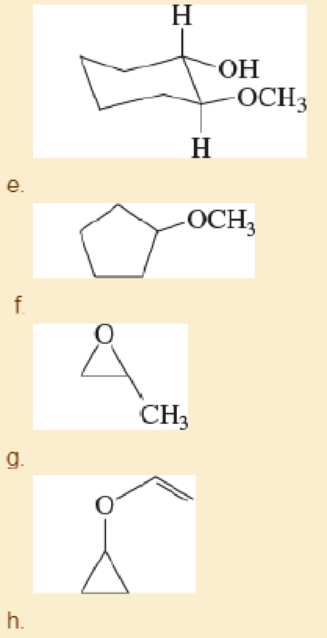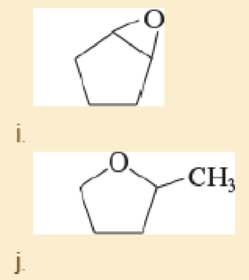
Organic Chemistry Plus Masteringchemistry With Pearson Etext, Global Edition
9th Edition
ISBN: 9781292151229
Author: Wade, LeRoy G.
Publisher: PEARSON
expand_more
expand_more
format_list_bulleted
Concept explainers
Textbook Question
Chapter 14, Problem 14.30SP
Give common names for the following compounds.
- a. (CH3)2CHOCH(CH3)CH2CH3
- b. (CH3)3COCH2CH(CH3)2
- c. PhOCH2CH3
- d. ClCH2OCH2CH2CH3


Expert Solution & Answer
Want to see the full answer?
Check out a sample textbook solution
Students have asked these similar questions
For which element is the 3d subshell higher in energy than that 4s subshell?
Group of answer choices
Zr
Ca
V
Ni
ii) Molecular ion peak
:the peak corresponding to the intact molecule (with a positive charge)
What would the base peak and Molecular ion peaks when isobutane is subjected
to Mass spectrometry? Draw the structures and write the molecular weights of
the fragments.
Circle most stable cation
a) tert-butyl cation
b) Isopropyl cation c) Ethyl cation. d) Methyl cation
6. What does a loss of 15 represent in Mass spectrum?
a fragment of the molecule with a mass of 15 atomic mass units has been lost during
the ionization Process
7. Write the isotopes and their % abundance of isotopes of
i) Cl
Choose a number and match the atomic number to your element on the periodic table. For your element, write each of these features on a side of your figure.
1. Element Name and symbol
2. Family and group
3. What is it used for?
4. Sketch the Valence electron orbital
5. What ions formed. What is it's block on the periodic table.
6. Common compounds
7. Atomic number
8. Mass number
9. Number of neutrons- (show calculations)
10. Sketch the spectral display of the element
11.Properties
12. Electron configuration
13. Submit a video of a 3-meter toss in slow-mo
Chapter 14 Solutions
Organic Chemistry Plus Masteringchemistry With Pearson Etext, Global Edition
Ch. 14.2C - Rank the given solvents in decreasing order of...Ch. 14.2D - Prob. 14.2PCh. 14.2D - In the presence of 18-crown-6, potassium...Ch. 14.3B - Give a common name (when possible) and a...Ch. 14.3C - Prob. 14.5PCh. 14.3C - Name the following heterocyclic ethers.Ch. 14.4 - Propose a fragmentation to account for each...Ch. 14.5 - Prob. 14.8PCh. 14.5 - Prob. 14.9PCh. 14.6 - Prob. 14.10P
Ch. 14.7 - Explain why bimolecular condensation is a poor...Ch. 14.7 - Prob. 14.12PCh. 14.7 - Prob. 14.13PCh. 14.8 - Prob. 14.14PCh. 14.8 - Prob. 14.15PCh. 14.8 - Prob. 14.16PCh. 14.10A - Prob. 14.17PCh. 14.10A - Prob. 14.18PCh. 14.10B - Prob. 14.19PCh. 14.11B - Show how you would accomplish the following...Ch. 14.11B - Prob. 14.21PCh. 14.12 - Prob. 14.22PCh. 14.12 - Prob. 14.23PCh. 14.12 - Prob. 14.24PCh. 14.13 - Prob. 14.25PCh. 14.13 - Prob. 14.26PCh. 14.14 - Prob. 14.27PCh. 14.15 - Give the expected products of the following...Ch. 14 - Write structural formulas for the following...Ch. 14 - Give common names for the following compounds. a....Ch. 14 - Give IUPAC names for the following compounds. a....Ch. 14 - Glycerol (propane-1,2,3-triol) is a viscous syrup...Ch. 14 - Prob. 14.33SPCh. 14 - Show how you would make the following ethers,...Ch. 14 - (A true story.) An inexperienced graduate student...Ch. 14 - Prob. 14.36SPCh. 14 - a. Show how you would synthesize the pure (R)...Ch. 14 - a. Predict the values of m/z and the structures of...Ch. 14 - The following reaction resembles the...Ch. 14 - Prob. 14.40SPCh. 14 - Prob. 14.41SPCh. 14 - Prob. 14.42SPCh. 14 - Give the structures of the intermediates...Ch. 14 - Prob. 14.44SPCh. 14 - Show how you would synthesize the following ethers...Ch. 14 - Prob. 14.46SPCh. 14 - Prob. 14.47SPCh. 14 - Prob. 14.48SPCh. 14 - An acid-catalyzed reaction was carried out using...Ch. 14 - Propylene oxide is a chiral molecule. Hydrolysis...Ch. 14 - Prob. 14.51SPCh. 14 - Prob. 14.52SPCh. 14 - Prob. 14.53SPCh. 14 - Prob. 14.54SPCh. 14 - In 2012, a group led by Professor Masayuki Satake...
Knowledge Booster
Learn more about
Need a deep-dive on the concept behind this application? Look no further. Learn more about this topic, chemistry and related others by exploring similar questions and additional content below.Similar questions
- [In this question, there are multiple answers to type in a "fill-in-the-blank" fashion - in each case, type in a whole number.] Consider using Slater's Rules to calculate the shielding factor (S) for the last electron in silicon (Si). There will be electrons with a 0.35 S-multiplier, electrons with a 0.85 S-multiplier, and electrons with a 1.00 S-multiplier.arrow_forwardProvide the unknown for the given data.arrow_forwardDraw the Lewis structures of two methanol (CH3OH) molecules and depict hydrogenbonding between them with dashed lines. Show all lone pairs. Provide a thorough analysis to apply concept idea into other problems.arrow_forward
- Steps and explanation please.arrow_forwardHow could you distinguish between each pair of compounds below using IR? For each pair citeone bond and it’s frequency that you could use to distinguish between them. Please provide thorough analysis to apply into further problems.arrow_forwardSteps and explanation please.arrow_forward
- Provide the unknown for the given dataarrow_forwardProvide the unknown for the given data.arrow_forwardElectron Arrangement A. Fill in the following chart relating to levels, sublevels and orbitals. Levels (n) 1 Sublevels # of Orbitals per sublevel 2 3 4 # of Electrons per sublevel Total Electrons per level Complete: B. Answer the following questions related to levels, sublevels, orbitals and electrons. 1. How many sublevels are in energy level 2? 2. How many orbitals are in a 4f sublevel? 3. How many electrons can level 3 hold? 4. How many orbitals are in level 4? 5. How many electrons can sublevel 2p hold? 11arrow_forward
arrow_back_ios
SEE MORE QUESTIONS
arrow_forward_ios
Recommended textbooks for you
 ChemistryChemistryISBN:9781305957404Author:Steven S. Zumdahl, Susan A. Zumdahl, Donald J. DeCostePublisher:Cengage Learning
ChemistryChemistryISBN:9781305957404Author:Steven S. Zumdahl, Susan A. Zumdahl, Donald J. DeCostePublisher:Cengage Learning ChemistryChemistryISBN:9781259911156Author:Raymond Chang Dr., Jason Overby ProfessorPublisher:McGraw-Hill Education
ChemistryChemistryISBN:9781259911156Author:Raymond Chang Dr., Jason Overby ProfessorPublisher:McGraw-Hill Education Principles of Instrumental AnalysisChemistryISBN:9781305577213Author:Douglas A. Skoog, F. James Holler, Stanley R. CrouchPublisher:Cengage Learning
Principles of Instrumental AnalysisChemistryISBN:9781305577213Author:Douglas A. Skoog, F. James Holler, Stanley R. CrouchPublisher:Cengage Learning Organic ChemistryChemistryISBN:9780078021558Author:Janice Gorzynski Smith Dr.Publisher:McGraw-Hill Education
Organic ChemistryChemistryISBN:9780078021558Author:Janice Gorzynski Smith Dr.Publisher:McGraw-Hill Education Chemistry: Principles and ReactionsChemistryISBN:9781305079373Author:William L. Masterton, Cecile N. HurleyPublisher:Cengage Learning
Chemistry: Principles and ReactionsChemistryISBN:9781305079373Author:William L. Masterton, Cecile N. HurleyPublisher:Cengage Learning Elementary Principles of Chemical Processes, Bind...ChemistryISBN:9781118431221Author:Richard M. Felder, Ronald W. Rousseau, Lisa G. BullardPublisher:WILEY
Elementary Principles of Chemical Processes, Bind...ChemistryISBN:9781118431221Author:Richard M. Felder, Ronald W. Rousseau, Lisa G. BullardPublisher:WILEY

Chemistry
Chemistry
ISBN:9781305957404
Author:Steven S. Zumdahl, Susan A. Zumdahl, Donald J. DeCoste
Publisher:Cengage Learning

Chemistry
Chemistry
ISBN:9781259911156
Author:Raymond Chang Dr., Jason Overby Professor
Publisher:McGraw-Hill Education

Principles of Instrumental Analysis
Chemistry
ISBN:9781305577213
Author:Douglas A. Skoog, F. James Holler, Stanley R. Crouch
Publisher:Cengage Learning

Organic Chemistry
Chemistry
ISBN:9780078021558
Author:Janice Gorzynski Smith Dr.
Publisher:McGraw-Hill Education

Chemistry: Principles and Reactions
Chemistry
ISBN:9781305079373
Author:William L. Masterton, Cecile N. Hurley
Publisher:Cengage Learning

Elementary Principles of Chemical Processes, Bind...
Chemistry
ISBN:9781118431221
Author:Richard M. Felder, Ronald W. Rousseau, Lisa G. Bullard
Publisher:WILEY
Lipids - Fatty Acids, Triglycerides, Phospholipids, Terpenes, Waxes, Eicosanoids; Author: The Organic Chemistry Tutor;https://www.youtube.com/watch?v=7dmoH5dAvpY;License: Standard YouTube License, CC-BY